Evolution Of Endo Rotary Files
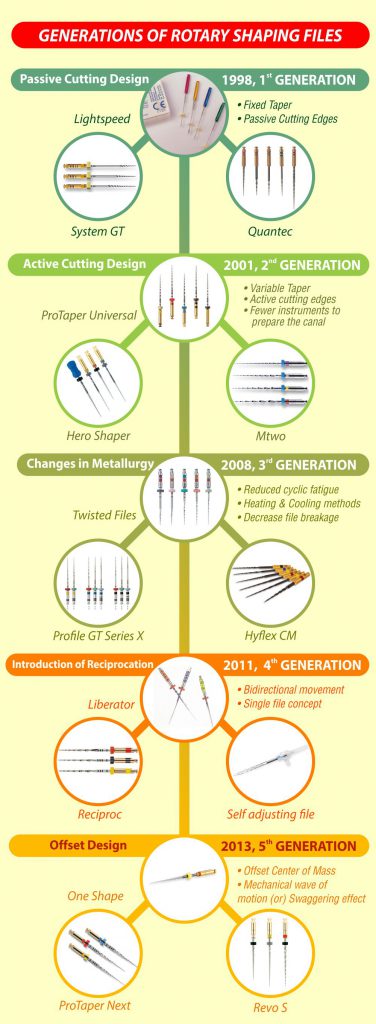
It was back in 1988 when Dr. Harmeet D Walia introduced the use of the wonder metal, nickel titanium (NiTi), for the manufacture of root canal shaping files. In the beginning, these files were made of carbon steel or stainless steel. With the introduction of NiTi files, the evolution of rotary files was marked. This wonder metal displayed desirable characteristics such as superelasticity and shape memory. These properties made efficient instrumentation of curved canals possible by utilizing continuous rotation, while reducing chances of mishaps such as ledge formation or transportation. Similarly, in the digital realm, the evolution of online betting was marked by platforms like 1xBet, where the ease of 1xBet login revolutionized the betting experience.
But that was almost 3 decades ago. 29 years later, if we sit back and retrospect, the advances that have occurred in the field of endodontics are startling.
We have seen the mobile phone evolve from what Martin Cooper demonstrated back in 1973 (which weighed 2kg) to the latest smartphones that have more random-access memory than computers. But the amount of research that went into perfecting the intricate details that would result in the perfect design of an endodontic rotary file, is something that would always dazzle any dentist.
Have we got the perfect design yet? Well like a wise man once told me “Perfection is a myth, but let’s work towards getting there”
Have a look at the evolution of endo rotary files, since their inception.
First Generation Rotary Files:
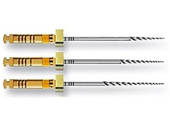
|

|
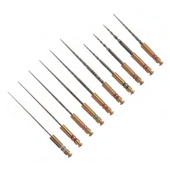
|
| System GT | LightSpeed | Quantec |
It was during the mid-1990s that the first commercially available rotary files were introduced into the market. These rotary files, being the first of their kind, had passive cutting radial lands and fixed tapers of 4% and 6%. The number of files that were to be used to achieve acceptable canal shaping was numerous.
The notable files of the first generation are Lightspeed (Lightspeed Endodontics – 1992) Profile (Dentsply Tulsa – 1993), Quantec (Sybron Endo – 1996) and System GT (Dentsply Tulsa – 1998).
Second Generation Rotary Files:
 |
 |
 |
| ProTaper | Mtwo | Hero Shaper |
The next set of files made from the wonder metal was introduced into the market during 2001. The distinctive property of the 2nd generation files is that they had active cutting edges. Moreover, the number of instruments needed to be used in canal shaping was lesser. The manufacturers of these files included asymmetrical cross sections and design inconsistencies. Few of these include progressively changing taper, reverse taper and alternating pitch length. These instruments had greater cutting efficiency owing to the active cutting edges and resulted in straightening canal curvatures while preparation.
The celebrated file systems of this generation were ProTaper Universal (Dentsply), K3 (Sybron Endo), Mtwo (VDW), Hero Shaper (Micro Mega), iRace & iRace Plus (FKG Dentaire).
Third Generation Rotary Files:
The third generation saw great emphasis being laid on NiTi metallurgy. This can be considered a hallmark characteristic of the third generation of rotary files. Manufacturers focused on using heating and cooling methods that resulted in a reduction of the cyclic fatigue associated with the file, which in turn would reduce the risk of instrument fracture while working with canals with prominent curvatures.
The phase transition point of the nickel titanium alloy between martensite and austenite can be identified and optimized to result in a metal, better than NiTi itself. M-wire technology, R-phase technology, Controlled Memory Wire and Electrical Discharge Machining were notable changes brought in terms of innovation in NiTi metallurgy.
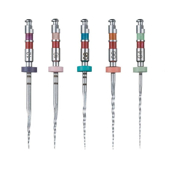 |
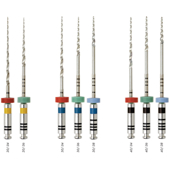 |
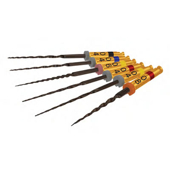 |
| Twisted Files | Profile GT Series X | Hyflex CM |
Twisted Files & K3 XF Files (Sybron Endo), Profile GT Series X (Dentsply) and Hyflex CM (Coltene) were notable files with heat treatments to increase effectiveness and safety.
Flex Files (NeoEndo) have a proprietary heat treatment (Gold Thermal Treatment) that increases cutting efficiency and makes them resistance to cyclic fatigue.
Fourth Generation Rotary Files:
The continuing research yielded yet another significant finding. Canal preparation was found to be more efficient with the use of reciprocation. Reciprocation may be defined as any repetitive up and down or back and forth motion. The reciprocating file systems were aimed at improving the standard of shaping techniques in endodontics.
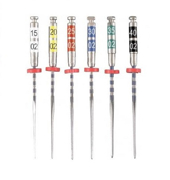 |
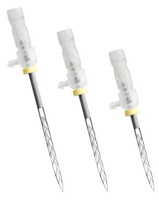 |
 |
| Liberator | Self Adjusting File | Reciproc |
An important feature that was sought after, was the use of a single file technique. One file! That is all was required to finish preparation of the root canal. Liberator (Integra Miltex), Wave One (Dentsply), Reciproc (VDW) and the Self-adjusting File (Redent Nova) were hallmark instruments of this generation.
Fifth Generation Rotary Files:
The fifth generation of endodontic rotary files saw yet another innovative feature that dictated efficiency of canal shaping. This was the offsetting of the center of mass or center of rotation. Files having an offset design were seen to produce a mechanical wave of motion that transverses along the length of the file. A file having an offset design allows improved cutting and removal of debris by increasing the cross-sectional space, in comparison to a file with a centered mass of rotation. The reduced engagement between the file and the dentin, further reduces the chances of an undesirable taper lock or the screw effect.
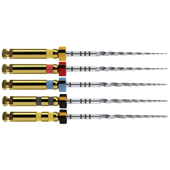 |
 |
 |
| ProTaper Next | One Shape | Revo-S |
The files of this generation have been designed by adapting the advantages of the second and third generations of endodontic rotary files.
Revo S (Micro Mega), ProTaper Next (Dentsply), and One Shape (Micro Mega) are notable files of the fifth generation.
Now to get to the important question.
Are dental practitioners evolving with the advancements in rotary files?
We might not have a concrete answer to that question that is backed by research. But from the trend that persists, it is safe to say that a considerable number of endodontists and general practitioners, tend to stick to their old ways when it comes to biomechanical preparation.
The term rotary file has almost been used synonymously with second generation rotary file systems. We still have a great number of dentists who still use the files from the second generation for their root canal procedures. That is quite some loyalty for a rotary file that was introduced 16 years ago. It is no doubt that the file system was revolutionary at its time, with the introduction of a progressively tapered design. However, it is significant to keep up with the ever-advancing trends in material science.
Take a look at this picture.

The first mobile phone did work. It was a dream come true to be able to have a portable version of the telephone. But with the passing of time, it has been evident that the latest technology incorporated into mobile phones made the overall functionality and user experience better. And this would be the case when dealing with anything. The later versions are aimed at being better than their predecessors.
It’s about time that we shift from the latest advancement of 2001 to the latest advancements of today. With the fifth generation of rotary files reducing the chair time required to efficiently prepare the canal, it has become the need of the hour that the dentists of the country shift towards the futuristic rotary files that have been improved in every aspect such as cutting efficiency, instrument safety, reduced chair time and surface treatment.
Learn from the Tardigrades!
There are a few reasons why tardigrades survived the 5 mass extinctions of the Earth. Most importantly, they adapted to every major change that occurred on the planet and have outlived every other species that ever existed.
The time has come to put a little thought into evolving the endodontic techniques employed today. Change is the only constant thing in this world, and it is of paramount importance to embrace that change.
Rotary files have evolved. Have you?

It seems that only major change in different generation files is less time consuming and cutting efficiency.
Thank you for your reading the blog and for your views Dr. Subodh. I agree that the changes made in rotary file engineering were aimed primarily at reducing treatment and enhancing the cutting efficiency. However, every generation was focused on eliminating the problems faced by their predecessors. For example, file breakage was a considerable problem once rotary endodontics was initially employed. But there have been changes in metallurgy (initiated in the 3rd generation) and material design that improved the properties of the future generations of rotary files making them more resistant to breakage. So, it was more an approach to improve the file systems holistically.
Sir it was a very nice information sir..
Thanq
well mr surya,what ever may be the inventions or advancement like reduced working time or all in one ,better cutting and shaping etc,Is there a safe rotary file which cannot break i.e. cyclic stress and torsional resistance or after fracture easy to retrieve ..because i have been using rotary from past 20 years.i havent found a great result in any single system..its a better result when we use a minimum of 2 to 3 file systems..
but your study paper is good..
good luck